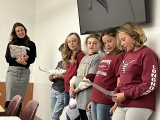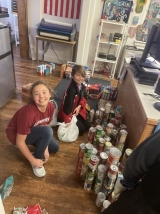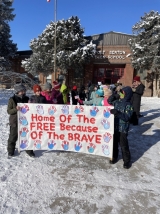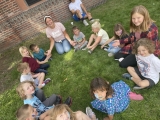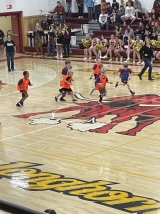-
Category 1
Selected in 2022
-
Grades: pre k - 6
School Setting: rural
Town Population: 2,000
Student Enrollment: 0
Student Demographics:
Black/African American: 0.5%
Teacher/Student Ratio: 1:14
White/Caucasian: 84%
Hispanic: 5.2%
Hawaiian/Pacific Islander: 0%
Asian: 0.5%
Native American: 5.2%
Other: 4.2%
% Reduced Lunch: 47%
% ELL Learners: 0%
Founded: 1926 -
PRINCIPAL:
Roxanne Benjamin -
CONTACT:
1820 Washington Street
Fort Benton, MT 59442
406-621-0083
rbenjamin@fortbenton.k12.mt.us
Fort Benton Elementary School
Fort Benton, MT
"Positive change is built around a positive environment."
- 1. Tell us about your school’s success.
- Our school's success is largely related to the fabulous teaching staff that we have that believe in supporting all students, doing whatever it takes to make sure that students are learning and growing, a whole school philosophy, and utilizing data to drive instruction. We have a core structure of RTI programs in place that help us utilize benchmark assessments to pinpoint the students that need the most support or guidance. We strongly believe that fair is not always equal and that mistakes are where the new learning goes! I love that our staff is willing to have difficult conversations and bring new ideas to the table because in the ever changing world of education, new ideas are essential! We have weekly common planning meetings that allow grade level teams to come together with administration and support staff to monitor student progress and work to implement personalized intervention plans to ensure that students are growing and learning. Fort Benton Elementary is out of this world
- 2. Talk about the greatest contributing factor(s) that promoted positive change in your school.
- Positive change is built around a positive environment and the RTI process gave teachers structure and resources to provide students with researched based intervention and support. We systematically progress monitor our students and through this process our staff has developed a common language centered around monitoring student growth and solution centered discussions. We also have built a culture of continuous learning and work to meet on our most intensive students every six weeks. This cycle allows us to keep eyes on our neediest students and make sure the interventions we are implementing are the most effective interventions for the child.
- 3. How has ESEA funding supported the school's success?
- The ESEA funding will support our school's success by providing further professional development opportunities for our staff. We are specifically utilizing the funds to provide more funding and opportunities for our staff to be trained in Right Brain Training. We will also utilize this funding to ensure that our interventionists are trained and that our intervention programs are fully stocked and replenished to ensure that the materials we need are available to our staff.
- 4. What professional development activities were used to improve teaching and learning?
- We utilized many different trainings but I believe that the High Trust Philosophy Training is one of the most effective trainings our district has and also the Right Brain Training is something that we are using support the development of our neediest students in reading, gross motor, and social/emotional development.
- 5. Talk about the cultural shift leading up to your school's success.
- The demographics of our school have changed quite a bit. Our free and reduced student population has increased as has the population of foster kids in our school. We have worked hard as a staff to build our knowledge regarding brain based teaching strategies and have worked intently to utilize them in the classrooms and throughout small group instruction. We now work more closely with our health department to provide more counseling services and support for our students and also have restructured the counseling support at school so we can have a half time counselor at the elementary school to meet with students and provide classroom support. We have attended Ruby Payne trainings and have worked hard to make sure that as our population changes and the academic and social emotional needs increase, we build up our brainpower and resources!
- 6. How has community involvement strengthened your success?
- The community is supportive of our school and wants to be engaged in events and what is happening.
Stats
-
Category 1
Selected in 2022
-
Grades: pre k - 6
School Setting: rural
Town Population: 2,000
Student Enrollment: 0
Student Demographics:
Black/African American: 0.5%
Teacher/Student Ratio: 1:14
White/Caucasian: 84%
Hispanic: 5.2%
Hawaiian/Pacific Islander: 0%
Asian: 0.5%
Native American: 5.2%
Other: 4.2%
% Reduced Lunch: 47%
% ELL Learners: 0%
Founded: 1926 -
PRINCIPAL:
Roxanne Benjamin -
CONTACT:
1820 Washington Street
Fort Benton, MT 59442
406-621-0083
rbenjamin@fortbenton.k12.mt.us


